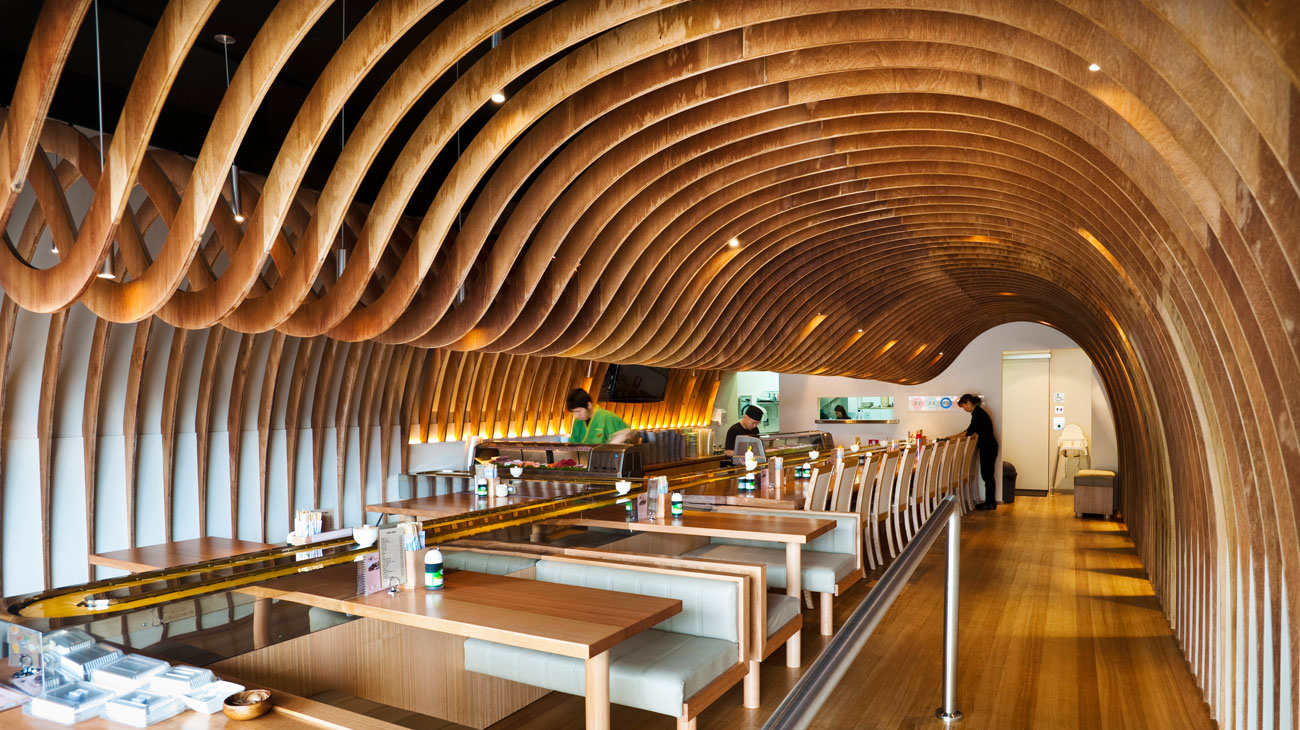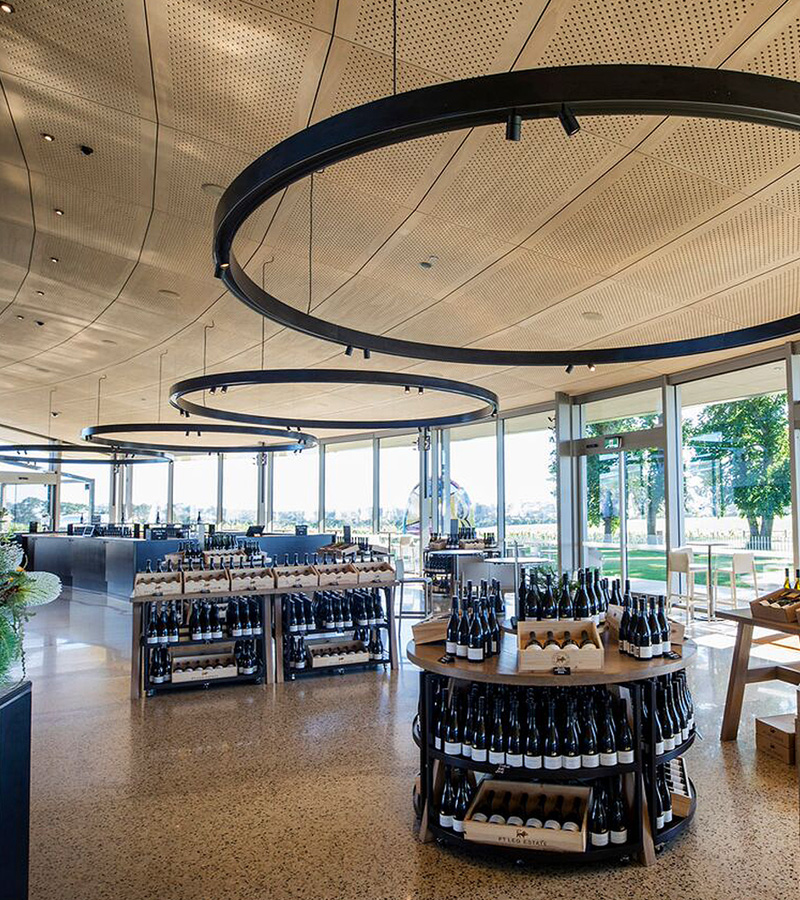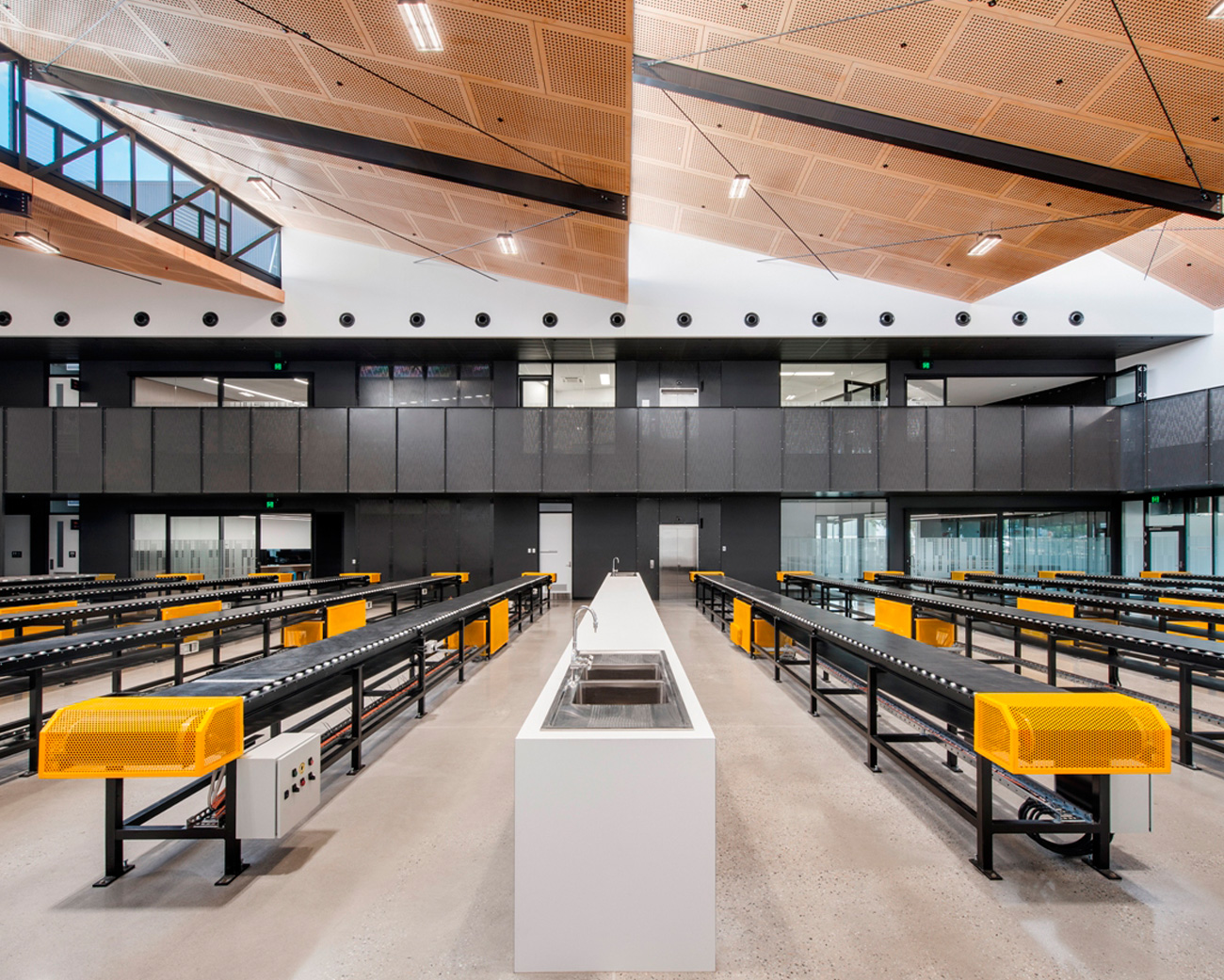
Recent years have seen a massive resurgence in the popularity of timber as a construction material, as architects and consumers are opting away from the previously established norms. Both in Australia and around the world, the architecture and design industry is recognising timber as a more versatile, higher quality, healthier, and more sustainable option than many other common construction materials. This has seen not only a major pivot back in favour of architectural joinery, but also the emergence of new timber technologies that improve upon the beneficial characteristics for which the material is already known.
One material that is gaining particular ground is plywood, in both its solid and perforated forms. Thanks to higher quality finishes and enhanced recognition of its long-standing qualities, plywood is no longer confined to use as an unseen, solely utilitarian, no-frills product. In this whitepaper, we take a closer look at timber and explore the reasons behind its re-emergence as a popular construction material. We also look at the key factors that set the new generation of plywood products on the market apart from previous products.
Design Versatility
Timber has always been a high performance material well suited for use in well-trafficked environments, and has historically been used without prejudice for furniture and throughout buildings’ structure and interiors. This remains true today – although with more flexibility than has ever been possible – making it ideal for use even in the busiest commercial or high-end residential spaces. Advances in timber technology have ushered in the possibility of timber skyscrapers; higher performing interiors in areas such as acoustics, maintenance and appearance; and more flexibility when it comes to choice of timber available for any given purpose.
Plywood in particular has seen significant growth in versatility and interest. What was once acknowledged simply as a “strong and durable construction material” has, in the eighty years since its standardisation, become a material valued for its aesthetics and multitude of alternate practical purposes as much as its structural capabilities.1 Given its excellent dimensional stability and uniform strength, plywood is still used today for concrete formwork and as structural bracing, but its role in contemporary architecture and construction has expanded to encompass floors, walls and ceiling linings, and cabinetry and furniture. Plywood’s perpendicular grain structure is unique in that it allows the benefits of solid timber without the risks of warping over time.
At larger scales, the same concept has been applied to Cross Laminated Timber, allowing the construction of taller, stronger timber structures than previously thought possible. With various sheet sizes and thicknesses available, in conjunction with larger, long-grain sheets being produced using contemporary manufacturing processes, plywood’s potential applications are constrained only by a designer’s own inventiveness. Furthermore, utilising plywood as interior linings can provide more than just a desired appearance, given the material’s inherent sound absorptive qualities. Acoustic reverberation within a space can be minimised further by utilising specially designed plywood acoustic panels, perforated to provide additional surface area without compromising on structural integrity.
[Plywood] has, in the eighty years since its standardisation, become a material valued for its aesthetics and multitude of alternate practical purposes as much as its structural capabilities.
Quality
Despite the popularity of steel and concrete for structural purposes, there is increasing awareness that timber can perform on par – or even better – in a number of specialty areas than the two aforementioned industry favourites for large scale projects. While steel can be structurally compromised in a fire, warping or twisting, structural grade timber will char on the outside and remain stable.2 Lighter than steel or concrete, timber is also more resistant to seismic activity, and can be put up faster, more quietly, and with less waste than alternatives.3
When it comes to interior linings and the higher standards associated with appearance-grade materials and high-quality furniture, the enhanced quality of both glue and plywood veneers used for the latest generation of plywood products means that plywood is equally as applicable in those circumstances as it is for structural assistance.
Plywood is graded against both its veneer quality and its glueline, determining, for instance, whether or not a sheet is suitable for use in wet areas, or whether a sheet’s appearance is of high enough quality to be shown as a painted or unpainted surface. Depending on design intent and budget, different veneers are available at different price points. The ply and thickness of a sheet of plywood also help determine its sturdiness, although this is also affected by the species of timber chosen and the glue-line used. With regular maintenance, properly specified plywood is durable and long lasting, resistant to premature wear and damage by design.

Effect on wellbeing
Numerous studies have shown the visible inclusion of timber has the ability to reduce stress and promote health and wellbeing in building occupants, expanding upon our previous understanding of the benefits of visible nature indoors, which has been linked to “lower pain perception, faster recovery times, fewer reported illnesses, fewer sick days taken, greater attention and creativity, reduced aggression, and better interpersonal relations”.4,5 One study, undertaken by Canadian non-profit FPInnovations and the University of British Columbia, found that “the presence of visual wood surfaces lowered… psychological stress responses,” such as increased blood pressure and heart rate, which under prolonged conditions are capable of causing physiological and psychological harm.6
These conditions can be common in environments such as offices, childcare centres and healthcare facilities, where timber such as plywood is becoming a popular choice for interior linings over sterile white walls. The warm look and feel of timber is inimitable by other construction materials, and as a result designers can be seen to be moving back towards a more ‘natural’ look in their pursuit of evidence-based and biophilic design. Beyond the documented psychological benefits, solid timber holds the additional benefit of being VOC-free, making it the healthier choice for interior environments. High quality plywood can also be found to be low- or no-VOC depending on the glue used, making it important to source from reputable Australian suppliers that adhere to the guidelines set out by the Australian Standards and other regulatory bodies.
Environmental Benefits
As climate change continues to threaten both natural and built environments, smarter construction is a simple way to cut back on carbon dioxide emissions and unhealthy practices. Building with timber products such as plywood is one of many ways to do this: coming from certified forests, timber products help support sustainable growth, local and growing economies, and some of the 1.6 billion people who at least partially depend on forests for their livelihood.7
Furthermore, while steel and concrete are thought to each contribute about 5 and 8 per cent of global carbon emissions respectively, trees actively store away CO2 and sequester it even after they have been logged.8 One 2014 study from the University of Washington found that using timber substitutes in place of steel and concrete could reduce CO2 emissions in construction by up to 31 per cent, attributable largely to “avoided emissions.”9
As the global construction industry is predicted to expand by an average of 2.2 per cent per annum in established economies through to 2020, finding efficient and effective ways to cut back on our environmental impact becomes even more crucial.10 The benefits of specifying timber products are also recognised by third party certification standards such as Green Star, with the use of timber products contributing towards achieving recognition for sustainable development both environmentally and for benefitting occupant health.
Conclusion
In this day and age, timber cannot be left to the wayside in favour of industry-standard materials such as steel and concrete. While arguments over cost or feasibility may have once been valid, this is no longer the case – despite being a natural resource, timber is being steadily improved upon with modern technologies, to the point that it can now compete with established practices.
This is evident through the design versatility, increasing quality, positive effects on our wellbeing and environmental benefits of such materials, and explains the re-emergence of such materials at the forefront of architecture and design today.
Keystone
For over 40 years, Keystone have produced architecturally designed interior linings and acoustic panels to create beautiful, functional and high performance spaces. With the help of Keystone engineers, architectural designers, CAD draftsmen and national project managers and an expansive selection of plywood wall, ceiling, acoustic and perforated panelling, designers can be confident their project is benefitting from the best possible choice. As an Australian owned and operated business, designers can also be assured occupants’ health is not being detrimentally impacted by non-conforming or non-complying products – knowingly or otherwise.
Key Ply
Keystone Key Ply is available in a wide selection of species including Euro Birch, Hoop Pine, and Radiata Pine, ensuring the perfect plywood for any project. Ideal for meeting elevated sustainability outcomes, the Euro Birch long grain Jumbo Key Ply is an FSC® certified A/B grade quality ply that has been fire rated in accordance with the Group 3 fire performance requirements of the Australian Standards.
As stunning as it is high performance, Euro Birch long grain Jumbo Key Ply also adds a high degree of visual interest thanks to a strong, distinctive grain that runs the full length of the sheet. Key Ply gives designers and architects a high degree of flexibility, with the multi-ply construction of Euro Ply creating a decorative edge that can add an elevated level of design flair. Oversize sheets allow for seamless, striking designs including higher ceilings, fewer joins in wall panels, and longer spans for ceilings and joinery.
The larger sheets also ensure greater sheet utilisation and reduced waste production. Keystone Key Ply is currently available in 3 sheet sizes (3050x1220x12mm, 3050x1530x12mm, and 3050x1530x18mm) and two thicknesses (12mm and 18mm), with 6 more sizes (3050x1220x9mm, 3050x1220x12mm, 3050x1220x18mm, 3050x1220x24mm, 3050x1220x30mm, 3050x1530x24 mm) still to come.
REFERENCES
1 A PA – The Engineered Wood Association. (n.d.). “History of APA, Plywood, and Engineered Wood”.
Accessed 10 May 2018. https://www.apawood.org/apas-history.
2 “Fire Testing Completed On Full-Scale Mass Timber Building”. 2017. American Wood Council.
http://www.awc.org/news/2017/07/13/fire-testing-completed-on-full-scale-mass-timber-building.
3 Deaton, Jeremy. 2016. “Wood-And-Glue Skyscrapers Are On The Rise”. Popular Science.
https://www.popsci.com/wood-and-glue-skyscrapers-are-on-rise.
4 Fell, David. 2010. “Wood in the Human Environment: Restorative Properties of Wood in the Built Indoor Environment”.
Electronic Theses and Dissertations (ETDs) 2008+. T, University of British Columbia. DOI : http://dx.doi.org/10.14288/1.0071305.
5 Fell, David. 2010. “Wood and Human Health”. FPInnovations. Accessed 11 May 2018.
https://www.nordic.ca/data/files/publication/Wood_Human_Health_final-single.pdf.
6 Ibid.
7 “Forest Habitat Overview”. (n.d.). World Wildlife Fund. Accessed 11 May 2018. https://www.worldwildlife.org/habitats/forest-habitat.
8 Gorvett, Zaria. 2017. “‘Plyscrapers’: The Rise Of The Wooden Skyscraper”. BBC.
http://www.bbc.com/future/story/20171026-the-rise-of-skyscrapers-made-of-wood.
9 Chadwick Dearing Oliver, Nedal T. Nassar, Bruce R. Lippke & James B. McCarter. 2014. “Carbon, Fossil Fuel, and Biodiversity Mitigation With
Wood and Forests”. Journal of Sustainable Forestry, 33:3, 248-275. DOI : https://doi.org/10.1080/10549811.2013.839386.
10 “Global Construction Market Predicted To Increase Nearly 4% Through 2020”. 2015. For Construction Pros.
https://www.forconstructionpros.com/business/news/12045491/global-construction-market-predicted-to-increase-nearly-4-through-2020





